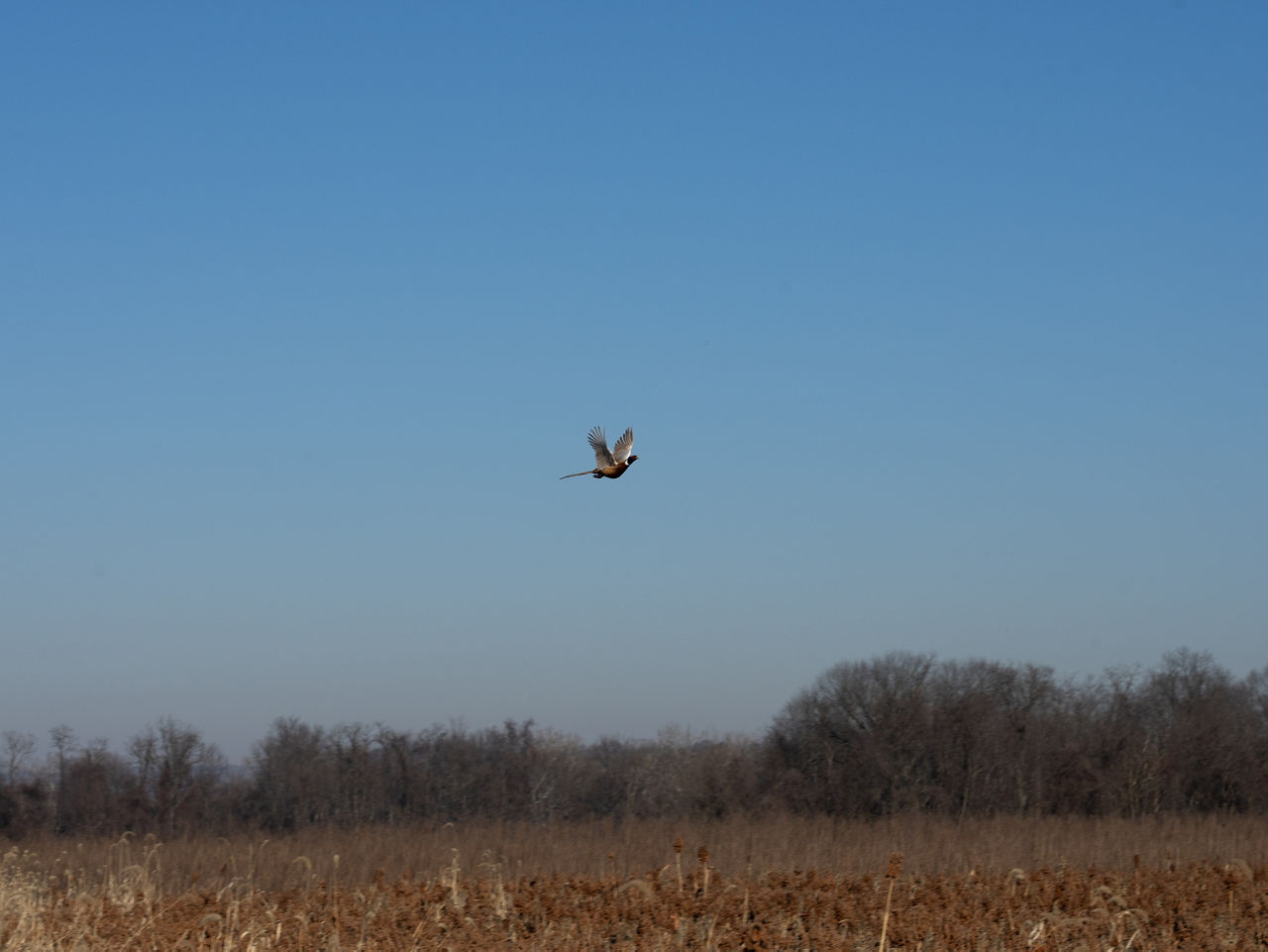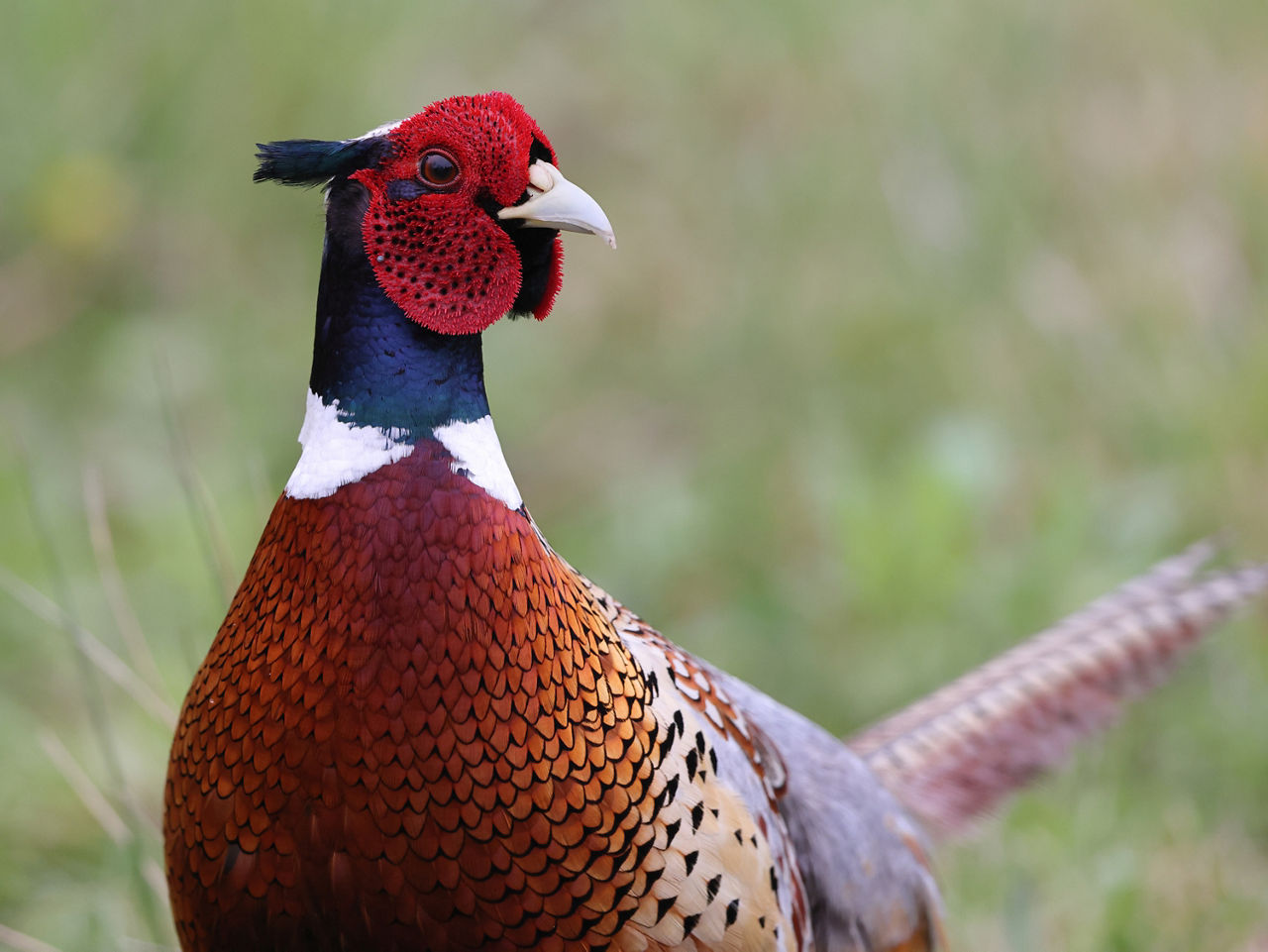An adult male weighs 2½ to 3½ pounds, an adult female weighs 2 pounds. Males are called roosters, cocks or cockbirds; females are hens. The standing height of a rooster is about 1 foot, and its length, from beak to tail tip, averages 36 inches. Hens are slightly smaller. A pheasant is long-legged and rangy through the body, with a long, pointed tail (20 to 23 inches) and short, rounded wings.
A hen's plumage is a subtle, camouflaging mixture of brown, black, and gray. In contrast, a rooster's feathers are a beautiful mix of reds, browns, golds and black. A rooster has scarlet cheek patches, a white neck ring usually interrupted in the front, an iridescent greenish-black head, golden-brown breast, and a greenish-gray or bluish rump and lower back. Tail feathers of both sexes are brown with black bars.
The crowing of a rooster is distinctive: A loud double squawk followed by rapid muffled wingbeats that might or might not be audible, depending on distance. Males crow most often during mating season, especially at sunrise and sunset; they might also emit a loud cackle when flushed into flight. Hens are normally silent.
Pheasants eat weed seeds (ragweed, smartweed, foxtails, etc.), grains (corn, wheat, barley, oats, beans and buckwheat), fruits and berries (raspberries, dewberries, strawberries, thornapples and barberry), shoots, leaves, grasses, rose hips and insects. They find a lot of their food by scratching through ground litter.
Like most birds, pheasants have sharp senses of hearing and sight. Extremely wary in autumn, they stick to dense cover when hunted heavily. During spring and summer they can be seen strutting across freshly mowed fields and along roadsides. When pursued, pheasants would rather run than fly, dodging nimbly into heavy cover—brambles, honeysuckle or multiflora rose. When cornered or surprised, they take to the air. Strong fliers over short distances, they attain a maximum speed of 45 mph in the open. Outside of breeding season (when roosters stake out individual territories) and brood-raising periods, pheasants are relatively gregarious, roosting in groups. In Pennsylvania, pheasants often roost in trees. The average pheasant ranges within 1 square mile.
Roosters claim individual breeding territories each spring. A rooster's courtship display includes spreading his tail and wings and strutting; his red cheek patches are swollen, his head is held low, and his neck feathers are ruffled. With luck and persistence, he will collect a harem of hens. Breeding begins in late March or early April and might extend into August. The male does not help incubate eggs.
Nesting occurs from April to August. A hen selects a nest site on the ground in a hayfield, a weedy field, an overgrown pasture or a brushy fencerow. A natural hollow (or one scraped out by the hen) is lined with weeds, grasses and leaves. Surrounding vegetation helps conceal both the nest and the laying or brooding bird.
The female lays six to 15 eggs (an average of 10 to 12) over a two-week period. Eggs measure about 1⅓ by 1⅔ inches and are light tan to pale olive green in color. Incubation is usually postponed until the last egg is laid, so all eggs receive equal incubation time and hatch on the same day. If eggs are destroyed by farm operations, predators, fires, or floods, hens might renest, with some even making up to three attempts.
The eggs hatch after 23 or 24 days of incubation. Most clutches hatch by early July. Like the young of other gallinaceous species, pheasant chicks are precocial —covered with down, their eyes open and able to run about and eat as soon as their down dries.
Chicks depend on the hen to shelter them from cold and rain. She does this by brooding, or sitting on top of them. Hens brood at night until young are able to roost in trees. Instinctively, chicks squat and remain motionless at a signal given by the hen; their coloration, tan with darker brown streaking, conceals them well. Foxes, raccoons, crows, weasels, house cats, dogs and hawks prey on the young.
The hen guides her chicks in food-finding. Insects, plentiful and high in protein, are a good early food. By 2 weeks of age, chicks can fly short distances; after 6 weeks, their adult plumage starts to come in; and by autumn, birds of the year look like adults. Young roosters can be told from older males by the length and hardness of their spurs, appendages growing out from the backs of their legs. In young birds, the spurs are relatively soft, blunt, and short (a quarter-inch or less). Older roosters have hard, sharp spurs up to an inch in length from spur tip to the front of the leg.
In winter, pheasants form flocks. During inclement weather, they stick to thick protective cover of conifers, brushy sloughs or forests overgrown with vegetation. While not commonly occurring, the following diseases afflict pheasants: coccidiosis, blackhead and pullorum. Flukes, tapeworms and roundworms parasitize some individuals. In sustainable wild pheasant populations, annual hen survival is 30 to 40 percent. Studies in Pennsylvania have determined that the annual removal rate for roosters can be as high as 90 percent without hurting the population.




